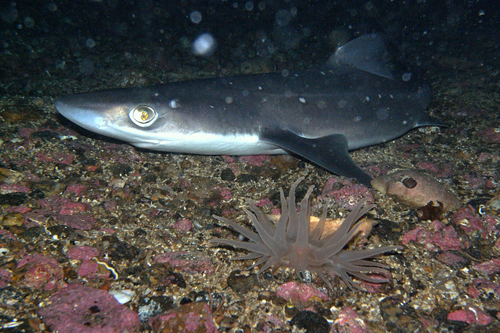
Spiny Dogfish
The Bluefin Tuna (Thunnus) are among the largest, fastest, and most commercially valuable fish in the ocean. Known for their incredible migrations and high-quality flesh, these impressive fish play a critical role in marine ecosystems.
30 75 years
Lifespan
100 - 124 cm
Length
Vulnerable
Conservation Status
15 km/h
Swimming speed
Carnivorous
Diet
Highly Migratory
Migration
Appearance Overview
The Bluefin Tuna is renowned for its large, streamlined body, built for speed and endurance.
Color
Dark metallic blue on top with a silvery underside
Fins
Two dorsal fins, the first depressible into a groove
Body Shape
Torpedo-shaped, designed for efficient swimming
Length
up to 10 feet (3 meters), commonly 6.5 feet (2 meters)
Weight
up to 1,500 lbs (680 kg), commonly 550 lbs (250 kg)
Diet
Carnivorous, feeding on fish, squid, crustaceans, and eel.
Feeding Behavior
Uses speed to chase down prey, sometimes in coordinated schools, employing a 'ram feeding' technique.
Social Behavior
Highly migratory, forming large schools, especially during spawning.
Commercial Relevance
Extremely high value in sushi and sashimi markets, driving significant economic interest.
Conservation measures
Fishing quotas, international agreements (ICCAT), marine protected areas, and efforts to reduce bycatch.
Status
Varies by species: Atlantic Bluefin - Endangered; Southern Bluefin - Critically Endangered; Pacific Bluefin - Vulnerable.
Threats
Overfishing, illegal fishing, climate change affecting prey distribution, and habitat degradation.
Habitat Distribution
Depth Range
0-900 meters, often found in surface waters but can dive deep.
Geographic Range
Atlantic Ocean, Pacific Ocean, Indian Ocean, and Mediterranean Sea.
Preferred Environment
Temperate and subtropical waters, open ocean, and coastal areas.
Reproduction and Life Cycle
Breeding Habits
Spawns in warm waters; Atlantic Bluefin in the Gulf of Mexico and Mediterranean Sea; Pacific Bluefin near Japan and the Philippines.
Development Stages
Larvae hatch in plankton-rich waters, developing rapidly through juvenile stages to adulthood.
Fecundity
Females can produce up to 30 million eggs per season, depending on size and age.
Maturity Age
Varies by species: Atlantic Bluefin matures at 4-8 years; Pacific and Southern Bluefin mature later (5-12 years).
Faqs about Spiny Dogfish
Where can Bluefin Tuna be found?
Bluefin tuna are found in the Atlantic, Pacific, and Indian Oceans, including the Mediterranean Sea.
How long do Bluefin Tuna live?
Bluefin tuna can live up to 40 years.
Are Bluefin Tuna warm-blooded?
Yes, they are warm-blooded, which helps them maintain high speeds and activity levels.
How fast can Bluefin Tuna swim?
They can swim at speeds up to 43 mph (70 km/h).
What is the biggest threat to Bluefin Tuna?
Overfishing is the primary threat due to their high commercial value.
What do Bluefin Tuna eat?
They are a top predator, feeding on a variety of fish, squid, and crustaceans.
When do Bluefin Tuna reach maturity?
Atlantic Bluefin Tuna mature at around 4-8 years, while Pacific and Southern Bluefin mature later.
How many eggs can a female Bluefin Tuna produce?
Females can release millions of eggs per spawning season.
How is Bluefin Tuna fishing regulated?
International organizations like ICCAT manage Bluefin Tuna stocks through quotas and regulations.
Copyright @ Nature Style Limited. All Rights Reserved.
 English
English